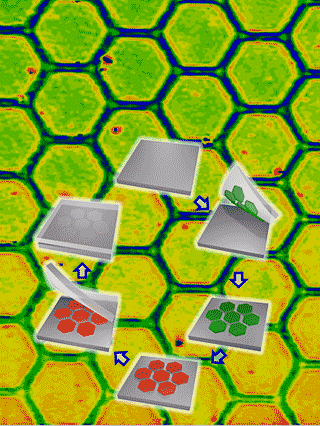A research team comprising Tingrui Pan and his colleagues from the University of California, Davis has developed an ultrathin ‘nanoglue,’ which finds applications in the fabrication of new-generation microchips.
 In this graphic, clockwise from top: the glue can be printed in a pattern on a surface, treated to make it sticky (red) and then a new layer stuck on top. The background is a patterned nanoglue on a surface. (Tingrui Pan/UC Davis photo)
In this graphic, clockwise from top: the glue can be printed in a pattern on a surface, treated to make it sticky (red) and then a new layer stuck on top. The background is a patterned nanoglue on a surface. (Tingrui Pan/UC Davis photo)
The research team has submitted a patent application for its invention. According to Pan, the glue would not peel off even after the material breaks. The nanoglue conducts heat and can be applied or printed in patterns on surfaces. Traditional glue sticks two surfaces together by forming a thick layer between them, while nanoglue forms a few-molecule thick layer.
The base material of the nanoglue is polydimethylsiloxane or PDMS, which is a flexible and transparent material. An ultrathin, sticky residue is usually left behind when this PDMS is removed from a smooth surface. The research team recognized that this residue can be utilized as glue by improving its bonding properties through oxygen treatment of the residue surface.
Using this nanoglue, several silicon wafers can be stacked up to fabricate innovative multilayered computer chip types. Pan believes that the novel glue may prove useful in household applications such as bonding objects to tiles or as a double-sided tape. This glue sticks only on smooth surfaces and can be peeled off with heat treatment.
The work was supported by the National Science Foundation. The research findings were reported in the Advanced Materials journal. Professor Alexander Revzin, postdoctoral researcher Michael Howland and graduate students Shaun Garland and Yuzhe Ding, all from the Department of Biomedical Engineering, were the co-authors of the paper.
Source: http://www.ucdavis.edu/